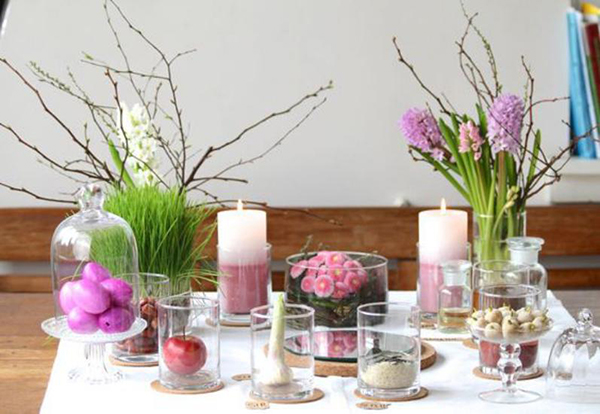March 15, 2019

The Now Ruz decoration found in every Iranian home is the Haft Seen arrangement. It is set up on a cloth on a carpet or upon a table several days before the spring equinox that marks the beginning of the New Year.
Haft is the Persian word for seven, and seen is the Persian letter that corresponds to “s” in English. Thus, Haft Seen literally means Seven S’es.
The Haft Seen arrangement consists of seven symbolic items that each begin with the letter seen. All together, these seven items represent the happiness that every family hopes to have during the New Year.
Traditionally, the seven items of the Haft Seen table are: sekeh (coin); samanu (a sweet wheat pudding); sabzi (sprouting green shoots of vegetables or herbs); sonbol (hyacinth flower); seer (garlic); senjed (a tiny, dried fruit from an Asian deciduous tree); and serkeh (vinegar). If all of these items are not available, appropriate substitutes include such “s” items as sib (apple) and sumagh (sumac). And there are family variations for the Haft Seen table, just as families have their own varying traditions for Christmas tree decorating in the West.
About an hour before the moment that signifies the arrival of spring, or Now Ruz, the family gathers around the Haft Seen to await the New Year.
Iranians wait for the exact moment of Now Ruz in much the same way Americans await the clock to strike midnight and turn December 31 into a new year. In Iran, canons have traditionally alerted the populace to the arrival of Now Ruz, although radio and television now perform the service.
The Haft Seen custom is at least 2,000 years old. In Sassanian Iran it was traditional to have a Haft Sheen arrangement in every home. Sheen is the Persian letter representing the “sh” sound.
When the majority of Iranians were converting from Zorastrianism to Islam—from the mid-7th Century to the 10th Century CE—the custom gradually changed from haft sheen to haft seen.
One widely believed reason for this change is that wine, or sharab, was traditionally part of the haft sheen table. Pious Muslims could thus avoid having wine as part of their New Year observance by an artful slip of the tongue.
Over the years, the Haft Seen has become a centerpiece for a variety of other items associated with Now Ruz. Many families set up a table that includes, in addition to the Haft Seen, such items as a mirror, boiled eggs, sweets, candles, and a bowl with a goldfish.
Many families include the Qoran on their Haft Seen table. Just before and after the moment of the equinox, the male head of the household recites from the Qoran.
The Haft Seen items, as well as the other decorations on the table, represent happiness and good fortune for the New Year. For example, the sekeh—preferably a gold coin, but at least a shiny new one—symbolizes the hope for adequate income for the family.
The samanu symbolizes sweetness in life, the sabzi fertility, that is, many children in the family, and the serkeh is to ward off bitterness. The lighted candles, the bowl of clear water in which a goldfish swims, the mirror, and the flowers all symbolize good luck.
Eating of the foods on the Haft Seen table also brings luck, but the Haft Seen must not be disturbed until after the New Year has begun. Sweets, or shirini, are always consumed right after the arrival of the equinox, but each family has its own traditions about when the samanu and senjed are eaten.
The sabzi is planted several weeks before Now Ruz in order that a healthy crop of sprouts will be ready in time for Now Ruz. The sabzi greens are saved until the final day of the Now Ruz season, Sizdeh Bedar, the 13th day after Now Ruz. It is considered very bad luck to remain at home on this day. Families go on picnics, taking along with them the sabzi.
Rural families tend to transplant the sabzi into the ground. Urban families tend to toss the sabzi into a stream of running water.
